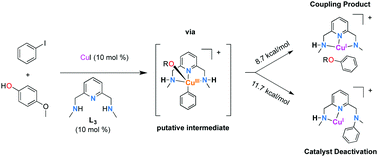当前位置:
X-MOL 学术
›
Chem. Commun.
›
论文详情
Our official English website, www.x-mol.net, welcomes your
feedback! (Note: you will need to create a separate account there.)
A CuI/CuIII prototypical organometallic mechanism for the deactivation of an active pincer-like CuI catalyst in Ullmann-type couplings
Chemical Communications ( IF 4.3 ) Pub Date : 2017-07-13 00:00:00 , DOI: 10.1039/c7cc04491g Mireia Rovira 1, 2, 3, 4, 5 , Lucie Jašíková 6, 7, 8, 9, 10 , Erik Andris 6, 7, 8, 9, 10 , Ferran Acuña-Parés 1, 2, 3, 4, 5 , Marta Soler 1, 2, 3, 4, 5 , Imma Güell 1, 2, 3, 4, 5 , Ming-Zheng Wang 1, 2, 3, 4, 5 , Laura Gómez 1, 2, 3, 4, 5 , Josep M. Luis 1, 2, 3, 4, 5 , Jana Roithová 6, 7, 8, 9, 10 , Xavi Ribas 1, 2, 3, 4, 5
Chemical Communications ( IF 4.3 ) Pub Date : 2017-07-13 00:00:00 , DOI: 10.1039/c7cc04491g Mireia Rovira 1, 2, 3, 4, 5 , Lucie Jašíková 6, 7, 8, 9, 10 , Erik Andris 6, 7, 8, 9, 10 , Ferran Acuña-Parés 1, 2, 3, 4, 5 , Marta Soler 1, 2, 3, 4, 5 , Imma Güell 1, 2, 3, 4, 5 , Ming-Zheng Wang 1, 2, 3, 4, 5 , Laura Gómez 1, 2, 3, 4, 5 , Josep M. Luis 1, 2, 3, 4, 5 , Jana Roithová 6, 7, 8, 9, 10 , Xavi Ribas 1, 2, 3, 4, 5
Affiliation

|
Unraveling the mechanistic details of copper-catalyzed arylation of nucleophiles (Ullmann-type couplings) is a very challenging task. It is a matter of intense debate whether it is a radical-based process or an organometallic redox-based process. The ancillary ligand choice in Ullmann-type couplings plays a key role in such transformations and can strongly influence the catalytic efficiency as well as the mechanism. Here, we show how a predesigned tridentate pincer-like catalyst undergoes a deactivation pathway through a CuI/CuIII prototypical mechanism as demonstrated by helium-tagging infrared photodissociation (IRPD) spectroscopy and DFT studies, lending a strong support to the existence of an aryl–CuIII species in the Ullmann couplings using this tridentate ligand.
中文翻译:

Cu I / Cu III原型有机金属机制,用于钝化Ullmann型偶联中的活性钳状Cu I催化剂
阐明亲核试剂的铜催化芳基化(Ullmann型偶联)的机理细节是一项非常具有挑战性的任务。无论是基于自由基的过程还是基于有机金属氧化还原的过程,都引起了激烈的争论。乌尔曼型偶联中辅助配体的选择在此类转化中起关键作用,并且可以强烈影响催化效率及其机理。在这里,我们展示了预先设计的三齿钳状催化剂如何通过Cu I / Cu III原型机制经历失活途径,如氦标记红外光解离(IRPD)光谱法和DFT研究所证明的那样,为存在一种强力支撑提供了有力支持。芳基铜III 使用该三齿配体的Ullmann偶联中的其他物种。
更新日期:2017-07-22
中文翻译:

Cu I / Cu III原型有机金属机制,用于钝化Ullmann型偶联中的活性钳状Cu I催化剂
阐明亲核试剂的铜催化芳基化(Ullmann型偶联)的机理细节是一项非常具有挑战性的任务。无论是基于自由基的过程还是基于有机金属氧化还原的过程,都引起了激烈的争论。乌尔曼型偶联中辅助配体的选择在此类转化中起关键作用,并且可以强烈影响催化效率及其机理。在这里,我们展示了预先设计的三齿钳状催化剂如何通过Cu I / Cu III原型机制经历失活途径,如氦标记红外光解离(IRPD)光谱法和DFT研究所证明的那样,为存在一种强力支撑提供了有力支持。芳基铜III 使用该三齿配体的Ullmann偶联中的其他物种。











































 京公网安备 11010802027423号
京公网安备 11010802027423号